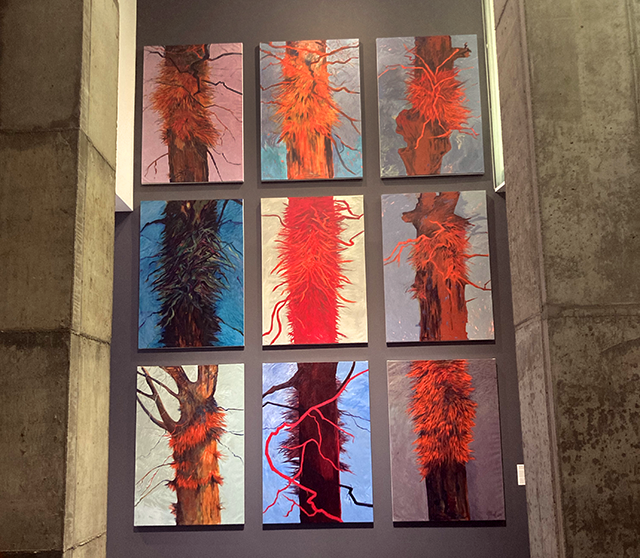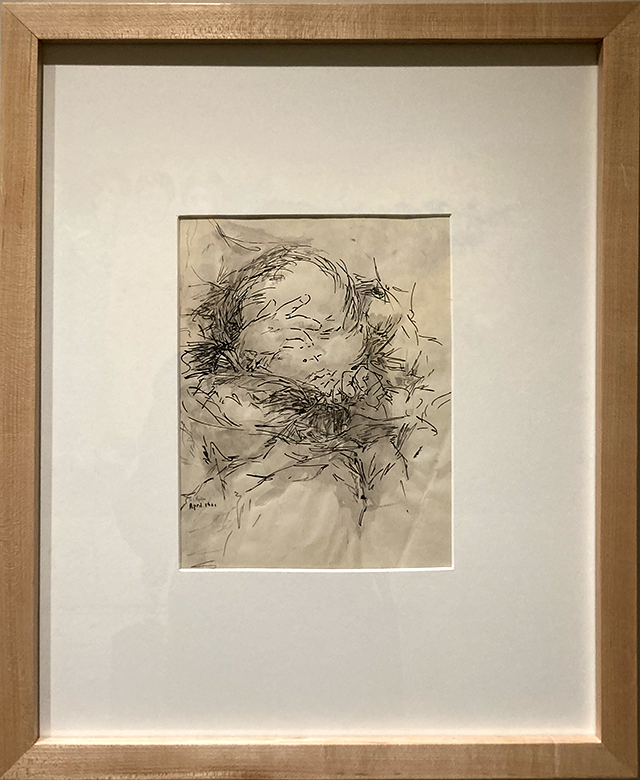A long-awaited exhibition of paintings, drawings and sculpture by Minnesota artist Hazel Belvo called “For Love” reopens the Minnesota Museum of American Art in St. Paul, which had been closed to the public since the start of the COVID-19 pandemic.

Her artistic practice is deeply personal, and also spiritual. Through her career, she’s engaged in different trajectories, often drawing from her own life — whether that be drawings made on the day she gave birth to her son Briand, her experience watching her son Joe suffer terminal illness, or her 50-year exploration of a single tree.
The exhibition features Belvo’s “Spirit Tree” paintings, a marvelous series featuring a particularly twisting tree that grows on the shores of Lake Superior called Manidoo-giizhikens (Little Cedar Spirit Tree) by the Ojibwe. The tree grows on the Grand Portage reservation, which is also where Belvo lived and worked with George Morrison, a celebrated Anishinaabe abstract painter and sculptor, who was married to Belvo from 1960 to 1991. They had their studio together at a place they named Red Rock.
Belvo painted the Little Cedar Spirit Tree many times over decades, but she’s also found connection to other trees over her life, including as a child, and more recently, to a honeylocust tree.
Nine large-scale paintings from a new series called “Spirit Tree: Honey Locust” are hung in the two-story atrium area of the museum, visible both from the first floor and also the skyway.

Belvo’s solo exhibition comes at a big moment for the M as it’s the first exhibition since the start of the exhibition where the public enters inside the gallery spaces. The museum has held exhibitions viewable through its large windows that face Robert Street, but Laura Wertheim Joseph, curator of exhibitions at the M, who curated the exhibition with Dakota Hoska, says the Belvo exhibition wasn’t a good fit for that program.
For one thing, many of Belvo’s drawings are very delicate, and couldn’t be shown through the windows because of light exposure. In addition, a key aspect of the exhibition features Belvo’s erotic drawings, which could be shown in the context of public art facing the street.

When the drawings have been shown in the past, they’ve often been shown with a curtain in front of them, like a peep show. “Hazel is very intentional about how she wants the work to be represented,” Wertheim Joseph says. “There needs to be some context so that they don’t get misconstrued and they don’t get sensationalized.”
The exhibition tracks many different periods Belvo has explored throughout her career, from meditative floral still life works to portraits of people she has admired. There are landscape works as well, like the terrific “Fireweed I, Highway 62” (2009). It glows with a pink and purple sky, and explodes with the colors of the fireweed bursting from the tall grasses.
Belvo’s “The Blue Painting” is like a landscape in the way it captures the feeling and mood of a place. She made the piece in 1959-1960 while studying at the Dayton Art Institute in Ohio. “An interest in expressing the emotional quality of place and knowing it deeply is a long-standing aspect of her practice that I think you can see in that piece,” Wertheim Joseph says.
The sculptural works in the show are noteworthy as well. One piece features avocado seeds planted in glass tubes, their roots cascading beneath them. A beautiful poem accompanies work, honoring Belvo’s own ancestors.
The exhibition started to be planned before the pandemic, when Hoska, an independent curator and painter proposed the idea for the show to the museum. Wertheim Joseph says she was excited because of the resonance of Belvo’s work, and also because the M already has a substantial collection of George Morrison’s work.

COVID delayed the exhibition, as did leadership changes at the museum. In 2020, the museum fired its executive director, Kristin Makholm, with Kate Beane assuming that role in the fall of 2021. The museum has also faced a significant reduction in staff, currently operating with 10 people instead of the 20 people before the pandemic.
In the meantime, the museum has undergone a capital campaign to start Phase 2 of construction carving out dedicated space for its permanent collection in the Pioneer Endicott Building. With funding complete, the construction is now underway and scheduled to be completed in 2024.
“It’s a big achievement for us,” Wertheim Joseph says.


0 Commentaires